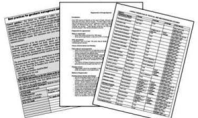CGKB News and events decision support tool
Decision support tool
Contact persons for Decision support tool: Daniela Horna, Jose Falck-Zepeda (IFPRI)
Contributors to this page: IFPRI, Washington (Daniela Horna, Melinda Smale); Bioversity International, Rome (Brigitte La Liberte); CIAT, Cali, Colombia (Arsenio Ciprian, Maritza Cuervo, Daniel Debouck, Roosevelt Escobar, Angela Marcela Hernandez, Graciela Mafla, Josefina Realpe Martinez, Luis Guillermo Santos, Orlando Toro); CIMMYT, Mexico (Victor Chavez, Bibiana Espinoza, Jonalyn Gumafelix, Thomas Payne, Marcial Rivas, Suketoshi Taba); ICRISAT, Patancheru, India (K.N. Reddy, V.G. Reddy, Dintyala Sastry, S. Singh, RP. Thakur, Hari D Upadhyaya); IITA, Nigeria (Ogundapo Ademola, Dominique Dumet, Victor Manyong); ILRI, Addis Ababa (Jean Hanson); Independent consultants (Victor Komerell, Bonwoo Koo); IRRI, Los Baños, Philippines (Socorro Almazan, Genevieve Mae Aquino, Patria Gonzales, Flora Guzman, Ruaraidh Sackville-Hamilton, Arvind Kumar, Charina Ocampo, Renato Reaño, Teresita Santos, Anthony Telosa, Miriam Telosa); AfricaRice, Cotonou, Benin (Ines Sanchez, Koichi Futakuchi).
Cost-effectiveness of collection management: Ex situ Conservation of Plant Genetic Resources in the CGIAR system
Through the participation in the GPG2 project the genebank from the CG system, SGRP and IFPRI have developed methods for assessing the costs and benefits of genebank operations. Since not all benefits associated with genebank operations can be estimated with certainty in quantitative terms, achieving cost-effectiveness (minimizing costs for a specific objective) is perhaps a more realistic goal than achieving efficiency (setting all marginal costs equal to all marginal returns). In consultation with genebank managers, a System-wide analysis has been undertaken to characterize the constraints, strategic choices and daily management decisions of genebank managers. A prototype methodology, including a computerized decision support tool has been developed and critiqued by System-wide genebank managers. Using the prototype tool, scenarios have been developed and hypotheses tested about the cost-effectiveness of integrating tasks and operations across the system.
Click on the image to download:
|
The decision support tool prototype (2 MB) Download the prototype of the decision support tool by clicking on the image above. To be able to open this tool you will need Microsoft Office
|
The decision support tool survey Participate in improving this decision support tool by sending your comments to Daniela Horna or by filling out the survey.
|
|
The user guide Click on the image above to proceed |
The final report (6.5 MB) Click on the image to access the GPG2 Final Report on evaluating the cost-effectiveness of collection management of plant genetic resources. |
References and further reading
Altoveros NC, Ramanatha Rao V. 1998. Analysis of information on seed germplasm regeneration practices. In: Engels JMM, Ramanatha Rao V, editors. Regeneration of Seed Crops and their Wild Relatives: Proceedings of a Consultation meeting, 4-7 December 1995, ICRISAT, Hyderabad, India. IPGRI, Rome, Italy. Available here.
Burstin J, Lefort M, Mitteau M, Sontot A, Guiard J. 1997. Towards the assessment of the costs of genebank management: conservation, regeneration and characterization. Plant Varieties and Seeds 10:163-172.
Calles T, Dulloo ME, Engels JMM, van den Houwe I. 2007. Best practices for germplasm management: A new approach for achieving genebank standards. Bioversity International. Available here.
Chakrabarty SK, Anitha K, Girish AG, Sarath Babu B, Rao PRDVJ, Varaprasad KS, Khetarpal RK, Thakur RP. 2005. Germplasm exchange and quaantine of ICRISAT mandate crops. Information Bulleting No. 69. Plant Quarentine Laboratory, ICRISAT, Patancheru, India.
Day-Rubenstein K, Heisey P, Shoemaker R, Sullivan J, Frisvold G. 2005. Crop genetic resources: An economic appraisal. A report from the economic research service. Economic Information Bulletin Number 2. United Stated Department of Agriculture.
De Boer L. 1992. Economies of scale and input substitution in public libraries. Journal of Urban Economics 32 (2):257-268.
ECPGR. 2008. A strategic framework for the implementation of a European genebank integrated system (AEGIS). Discussion Paper. European Cooperative Programme for Plant Genetic Resources (ECPGR). Bioversity International, Rome, Italy.
Engels JMM, Ramanatha Rao V. 1998. Regeneration of Seed Crops and their Wild Relatives: Proceedings of a Consultation meeting, 4-7 December 1995, ICRISAT, Hyderabad, India. IPGRI, Rome, Italy. Available here.
Epperson J, Pachico DH, Guevara C. 1997. A costs analysis of maintaining cassava plant genetic resources. Crop Science 37:1641-1649.
FAO. 2002. International Treaty on Plant Genetic Resources for Food and Agriculture: A global treaty for food security and sustainable agriculture. Food and Agriculture Organization of the United Nations, Rome, Italy.
Finch L, Christianson JB. 1981. Rural hospitals costs: an analysis with policy implications. Public Health Reports 96:423-433.
Fowler C, Hodgkin T. 2004. Plant genetic resources for food and agriculture: Assessing global availability. Annual Review of Environment and Resources. Vol. 29:143-179.
Hardaker JB, Huirne RBM, Anderson JR. 1997. Coping with risk in agriculture. Wallingford: CAB International.
Johnson N, Pachico D, Voysest O. 2003. The distribution of benefits from public international banks: the case of beans in Latin America. Agricultural Economics 29:277-286.
Koo B, Pardey PG, Wright BD. 2003. The economic costs of conserving genetic resources at the CGIAR centres. Agricultural Economics 29:287-297.
Koo Bonwoo, Pardey PG, Wright BD, Bramel P, Debouck D, van Dusen ME, Jackson MT, Rao NK, Skovmand B, Taba S, Valkoun J. 2004. Saving seeds: The economics of conserving crop genetic resources ex-situ in the future harvest centres of the CGIAR. Oxfordshire, UK: CABI Publishing.
Koo B, Wright BD. 2008. The optimal timing of evaluation genebank accessions and the effects of biotechnology. American Journal of Agricultural Economics 82 (4):797-811.
Li D, Prtichard H. 2009. The science and economics of ex situ plant conservation. Special issue: Plant science research in botanic gardens.
Liu LG. 2002. The cost functions and scale economies in academic research libraries. Library Trends 2002:406-420.
Mafla G, Roa JC, Aranzales E, Debouck DG. Handbook of procedures for in-vitro germplasm conservation of the genus Manihot. Genetic Resources - CIAT: Cali, Colombia.
Pardey PG, Koo B, van Dusen ME, Skovmand B, Taba S. 2001. Costing the Conservation of Genetic Resources: CIMMYT's Ex Situ Maize and Wheat Collection. Crop Science 41:1286-1299.
Rao NK, Hanson J, Dulloo ME, Ghosh K, Nowel D, Larinde M. 2006. Manual of seed handling in genebanks. Handbooks for Genebanks No. 8. Bioversity International, Rome, Italy. Available in English (1.5 MB), Spanish (1.4 MB) and French (1.9 MB).
Salcedo J, Debouck DG, Torres AM, Guevara C. 2006. Flow Chart of Operations for Bean and Tropical Forage Germplasm. Genetic Resources - CIAT: Cali, Colombia.
Smale M, Drucker AG. 2007. Agricultural Development and the Diversity of Crop and Livestock Genetic Resources: A Review of the Economics Literature. In: Kontoleon A, Pascual U, Swanson T, editors. Biodiversity Economics. Cambridge University Press.
Smale M, Koo B. 2003. Genetic Resources Policies: What is a Gene Bank Worth? IFPRI: Washington, D.C.: IFPRI, IPGRI, and the Systemwide Genetic Resources Program.
Taba S, van Ginkel D, Hoisington D, Poland D. 2004. Wellhausen-Anderson Plant Genetic Resources Center: Operations Manual. El Batan, Mexico: CMMYT.
Upadhayaya H, Gowda CLL, Sastry DVSSR. 2008. Plant genetic resources management: collection, characterization, conservation and utilization. SAT eJournal (ejournal.icrisat.org) An Open Source Journal published by ICRISAT: December 2006, Volume 6.
Virchow D. 2003. Current expenditures on crop genetic resources activities. In: Virchow D, editor. Efficient conservation of crop genetic diversity. Berlin: Springer-Verlag.
Virchow D. 1999. Spending on conservation of plant genetic resources for food and agriculture: How much and How efficient? ZEF Discussion Papers on Development Policy. Bonn: Center for Development Research.
Guide for users
Contributors to this page: IFPRI, Washington, USA (Daniela Horna); Independent consultants (Victor Komerell, Mauro Loayza).
|
Contents: |
|
Click on the image above to download the Decision Support Tool (2MB). |
As part of the Global Public Goods 2 Project, a prototype of a Decision Support Tool (DST) has been developed, based on the framework of Koo et al. (Saving Seeds, 2004). The tool can be used to:
- Document detailed input use per operation.
- Calculate the current costs of operating your genebank.
- Generate cost reports which can help you understand the cost structure of operating your genebank in the relevant year.
- Form the basis for making decisions about the efficient operation of your genebank in the long term.
The quality of such decision making will improve with the ability of multi-year comparisons, which will become possible as input information is entered in future years. Comparisons across genebanks will also make it possible to compare particular costs per similar type of accession or similar type of operation.
The tool serves to help each genebank identify its unit costs (e.g. cost of storing, regenerating etc. one accession) and, indirectly, to identify cost drivers (e.g. a factor which causes a change in the cost of an activity).
In future, the Tool can be improved to:
- Make it easier to input data.
- Include a purchasing power parity feature, so that more accurate comparisons of labour costs, for example, can be made.
- Generate other, different kinds of reports, driven by the decision making needs of one particular, or of all genebanks.
This is the second version of the DST. This version has been developed using Excel and Visual Basic. The main change in this version corresponds to its presentation and user friendliness. The basic structure for the estimation of genebank costs has not been affected.
The tool has a front page that presents a menu of ten options that are links to the different sections of the tool (Figure 1). The first eight boxes (blue) are links to data entry about: general information, crops, activity tables, capital costs-facilities, capital costs- equipment, quasi-fixed cost, variable costs-labour, variable costs-non labour. The menu on the front page also has a red box that is a link to the report(s) and a green box that presents the credits of the tool.
The boxes can be accessed independently or you can follow the order proposed by the tool. Once you enter the relevant cost information into the five sheets, several cost reports regarding your genebank will be automatically calculated in the ensuing sheets.
Always remember that the quality of the final cost reports critically depends on your inputs!
Figure 1. DST starting page
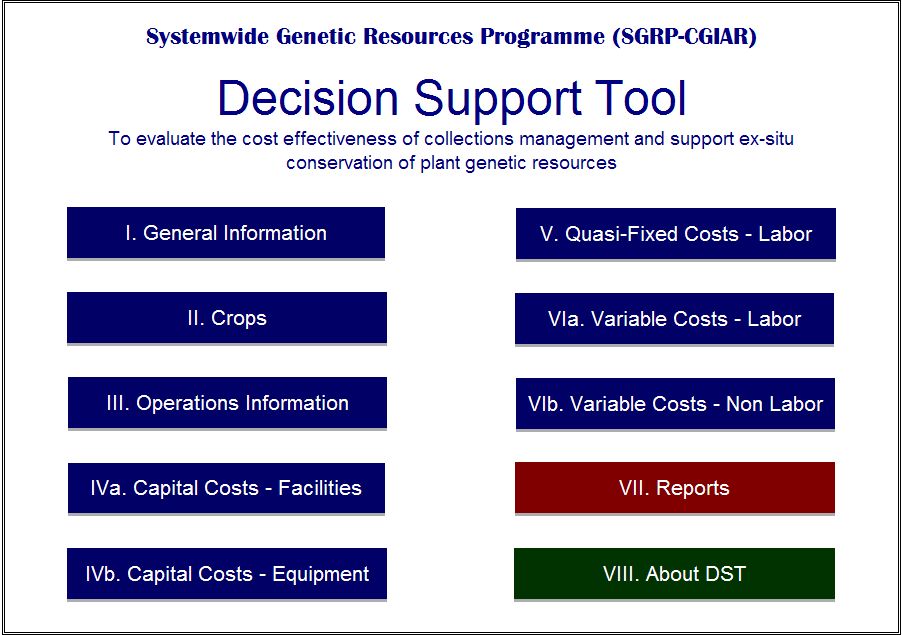
General Information
The general information box links to an entry form that serves to gather details about the genebank (e.g., genetic material, number of accession managed, etc.) and other factors that affect or can affect costs (e.g. discount factor used to estimate in-perpetuity costs, overhead rate). See Figure 2.
First, the user is requested to enter some general genebank information.
1. Year of reference - enter the year that is under evaluation.
2. Year that the genebank started operations.
3. Expected period of operation of the genebank.
4. Number of crops. The user is requested to enter the total number of types of genetic material that is held by the genebank. The tool will produce a report for each type of material.
Figure 2. General Information form
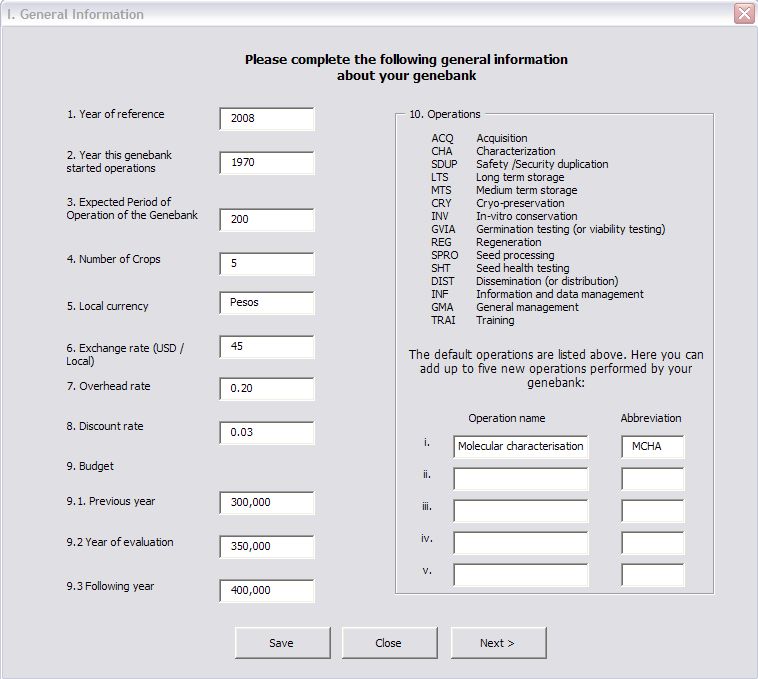
General Information
5. Local currency used in the country, where the genebank is located and exchange rate. While most of the expenses in the genebank are probably made in US dollars, some expenses are paid in the local currency. Fluctuations in the exchange rate can have a big effect on the final cost estimations.
6. Conversion or exchange rate during the year of evaluation (total local units equivalent to US$ 1).
Note: The cost information can be entered in local units or in US$. Points 3 to 6 are requested in order to appropriately perform conversions.
7. Overhead rate. Each Centre charges indirect costs or overhead rates (as a % of the total budget granted to a genebank/GRU). Some Centres charge an overhead AND a Research Support Services/DDG Research rate). This information is easily available in the finance department. The genebank costs are affected by the overhead rates charged by the host Centre. Overhead cost, also called operating expense, is the cost of maintaining property (e.g., paying property taxes and utilities and insurance); it does not include depreciation or the cost of financing or income taxes. This expense is not directly assigned to goods or services provided. Failing to include these overhead rates can lead to the underestimation of the total cost. The overhead rate is entered as a fraction of one, not as a percentage, therefore it normally varies from zero to one.
8. Discount factor. The value to be entered here is the average interest rate in the country where the genebank has their bank accounts. In the case of the CG system these accounts are usually kept in the US or sometimes in Europe. Therefore the value to use is the interest rate for the OECD countries. A discount rate is the interest rate used to find the present value of an amount to be paid or received in the future. This discount rate is used for annualizing the capital costs and also for estimating the in-perpetuity costs. The discount factor is entered as a fraction of one not as a percentage, therefore it varies from zero to one.
In the following three points the user is requested to enter some budget information. The objective of this request is to make comparisons between actual expenses and actual projected ones. These questions are not mandatory and will not affect the estimations of the genebanks costs.
9. Budget.
9.1. Previous year. Enter the budget prepared for the year previous to the year in evaluation.
9.2. Year of evaluation. Enter the budget information for the year of evaluation.
9.3. Following year. Enter the budget information for the year after the year of evaluation, if available.
How genebanks are organized and run depends on the type and range of accessions they hold and where they are located (e.g. the region, city or several locations etc.). It is difficult to incorporate all the differences into a single framework of operations (e.g. major activities, which all genebanks perform in one way or another). However, this tool categorizes various genebank operations in the following classification (Table 1.). In addition to the standard operations, a genebank can also perform other support operations. This is the purpose of point number 10 below.
10. Operations. You can add operations that are not included in Table 1. If the user would like to estimate the costs of these additional operations then the label has to be created here. Notice that you have to be ready to enter detailed information (number of accession manipulated, allocation of time and other resources per type of material, etc.) about this operation. Examples of other operations are biochemical & molecular characterization (in CIAT) and pre-breeding maize (in CIMMYT).
Table 1. List of standard operations, explanations and abbreviations used
|
Activity |
Explanation |
Code |
|
Acquisition |
This may involve the collection activities in the fields or the activities related to receiving and processing newly introduced accessions. |
ACQ |
|
Characterization |
This is the activity of recording the characteristics of each accession, often conducted during the regeneration process. |
CHA |
|
Safety duplication (or security duplication) |
This is the activity of sending sample accessions to different locations for safety reasons (i.e., backup collection). |
SDUP |
|
Long-term storage |
This activity is for the conservation of accessions in the long-term storage facility. Cold room and Cryopreservation mainly. |
LTS |
|
Medium-term storage |
This activity is for the conservation of accessions in the medium-term storage for ready dissemination upon request. Tissue culture, cold room, field genebank.
Notes:CIAT uses short-term storage (Corto Plazo). |
MTS |
|
Cryopreservation |
Cryopreservation / long-term storage. |
CRY |
|
In vitro conservation |
In vitro conservation / medium- and long-term storage, sub-culturing. |
INV |
|
Germination testing (or viability testing) |
This is the (periodic) activity of testing the germination rate of existing or newly multiplied accessions. |
GVIA |
|
Regeneration |
This is the activity of getting fresh seeds by planting out seeds for storage or dissemination. |
REG |
|
Seed processing |
This is the activity of packing, cleaning and drying seeds. |
SPRO |
|
Seed health testing |
This activity involves the testing of seed health, often carried out upon acquisition or during the regeneration process. |
SHT |
|
Distribution (or dissemination) |
This involves the activity of sending accessions upon request (e.g., preparation, shipment, etc). |
DIST |
|
Information and data management |
This activity includes data entering, processing and management (including catalogue preparation). |
INF |
|
General management |
This is the activity that is difficult to allocate to a specific activity (e.g., genebank manager's work). |
GMA |
|
Other |
Enter any other type of operation that is not included above. |
OTH |
Crops
This box links to a form (Figure 3.) where the user has to enter the information about the type of material stored and total number of accessions stored in the genebank. Note that in the previous form (general information) the user has entered the number of materials; therefore the program has created the correct number of spaces to enter this information.
The information about number of accessions per type of material is estimate weights that can be used to distribute costs across types of materials stored in the genebank (on the basis of an estimated allocation rate). The user must decide in advance the classification of the type of material.
For example, IRRI can define the material stored as rice only or classify its holdings as rice and wild rice. Please note that all further information gathered by the Tool will be related to the type of material, as you have defined it.
Figure 3. Crops form
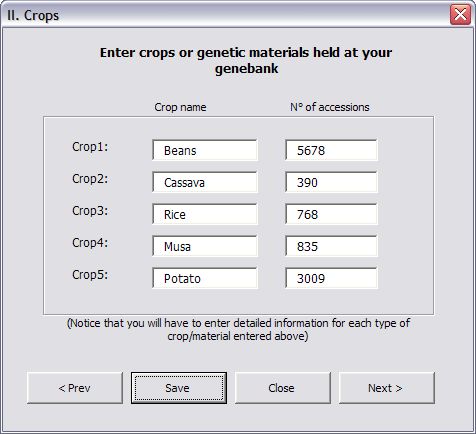
Operations Information
The form under this link requests three kinds of information about genebank operations:
1. Accessions processed (e.g. stored, regenerated, distributed to users, etc.) per type of material and per operation (Figure 4). This information will be used to develop a second allocation rate (across type of materials and per operation). It will also be used to proportionally distribute costs by the total number of accessions manipulated, when possible. In some cases such an allocation will not be possible. A clear example of this case is the manipulation of wild materials that often demand more resources and investment per accession than the cultivated materials.
Note that for general management and information management the value that has to be entered here is the total number of accessions. Also note that for the case of long-term and medium-term storage, the figure entered should be the total number of accessions stored for either case.
Figure 4. Operations Information: Accessions per operations form
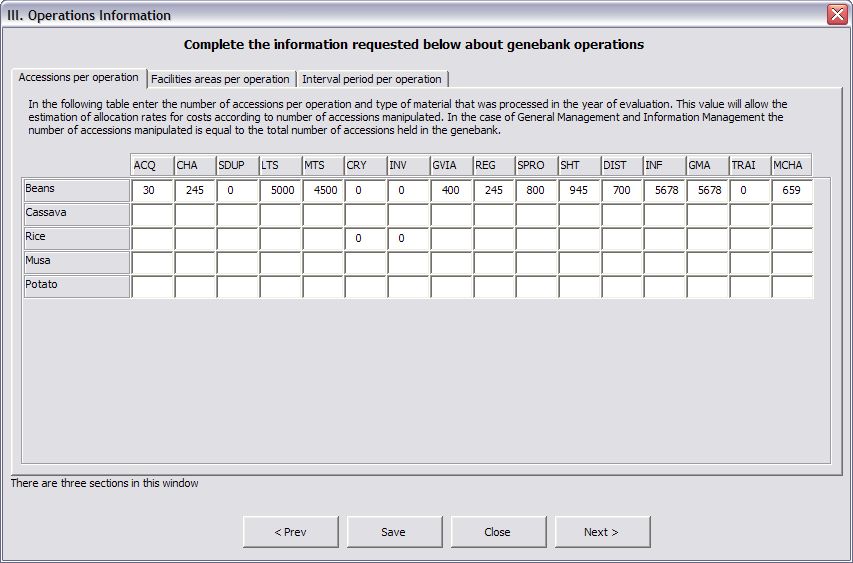
2. Facility area per operation. These figures are used to estimate the costs of the facilities (Figure 5). In future they will also be used to estimate service chargeback’s (or direct costs). Many genebanks in the CG system are ‘service-charged’ per square metre (m2) and this must be reflected in their budget requests. These charges usually correspond to services such as electricity, security, land use, computer equipment and services, information services (e.g. library), etc.
Figure 5. Operations Information: Facility area per operation form

3. Period of Operations. Genebanks differ with respect to the frequency (e.g. time scales), with which they perform certain operations (Figure 6). For instance, although viability testing is a routine operation, depending on the genebank's internal protocol, it is performed every 5 -10 years for the same accession. An accession of beans sent to Fort Collins for safety duplication in 2008 will probably only be replaced in 50 years or so. ‘Period of operations’ information is used to produce the in-perpetuity costs. Please note the interval may vary with the operation, some operations only need to be performed once (e.g. seed health testing), others are performed yearly (e.g. general management, information, long-term and medium-term storage), yet others do not have a specific interval period as they depend on the availability of funds (e.g. acquisition). The user has to select the correct option on the drop-down menu in each cell.
Figure 6. Operations Information: Interval period per operation form
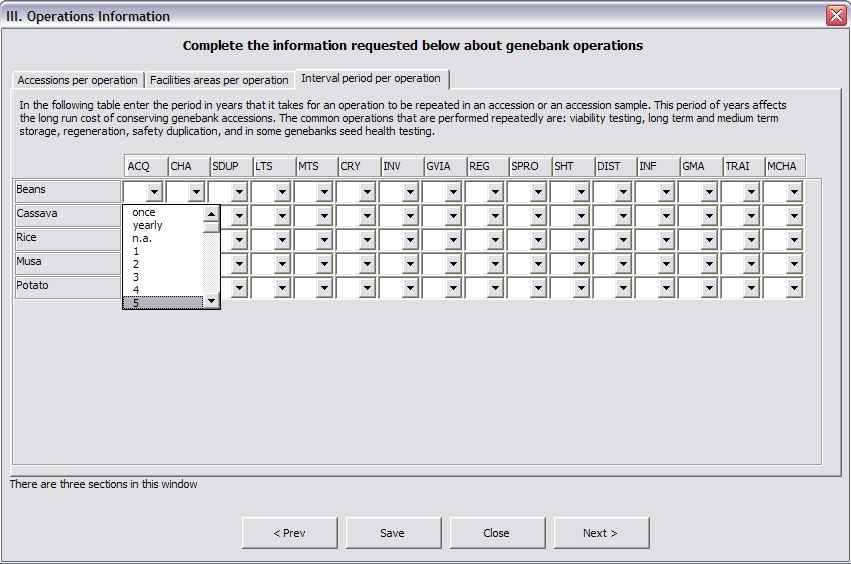
Capital Costs
In general, capital inputs are not sensitive to the size of the operation. The assumption is that a genebank needs buildings, lab equipment, etc. to operate at all, regardless of whether these capital inputs are used at full capacity or not. (Of course, sometimes genebanks need to expand, because their collections have grown or they perform new kinds of work, but that is related to Capital Investment, and thus to future costs of operations and not yet covered by the Tool). Capital inputs include infrastructure, such as germplasm storage and genebank facilities, and equipment for field operations and offices. In order to produce the annual costs of the genebank, current prices are converted to nominal prices using Consumer Price Index information already entered in the Tool and annualized using the discount rate requested in the General Information form.
Facilities
The user is requested to enter information about the genebank facilities (buildings, greenhouses, experimental plots, etc). The information requested is the basic information needed to estimate the annual costs to the genebank: Facility name, Year of construction or acquisition, Service life (in years), and Total costs of the facility (in local currency or US$). The user can enter the actual cost when the facility was built, or its current cost (area * cost of building(s)).
In addition, the user has to identify the main uses (operations) of the facility and allocate weights accordingly (Figure 7). The weights have to be expressed as fractions of 1 so they can vary from 0 to 1.
For instance if a greenhouse is used equally for regeneration and characterization the weight values used are 0.5 for characterization and 0.5 for regeneration.
Figure 7. Capital Costs - Facilities form
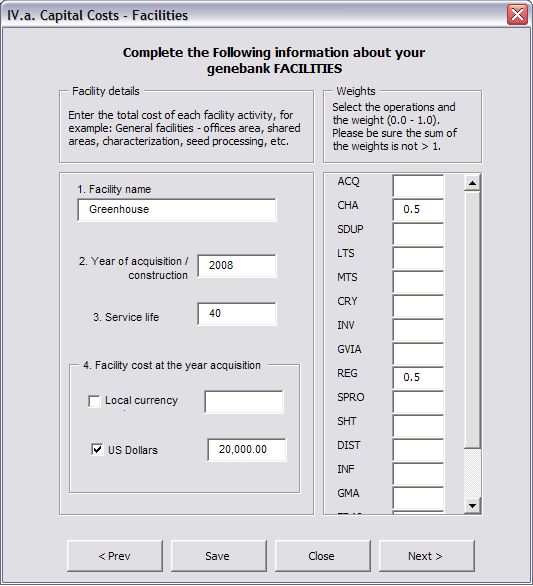
Equipment
To correctly account for the expenses of genebank equipment the user has to enter the historic information (usually kept by the finance department in each Centre) of all the functional equipment. The detailed information requested includes: Equipment name, Year of acquisition, Service life (according to the CG depreciation policy), Number of units acquired, and Original price of acquisition. The price information can be entered in local units or in US dollars.
As in the case of the facilities, the user is requested to enter allocation rates of weights according to the operation that the equipment is used for. Not every piece of equipment is used for all types of genetic materials, therefore the user also needs to enter the crop or crops that the equipment is used for (Figure 8).
Figure 8. Capital Costs - Equipment form
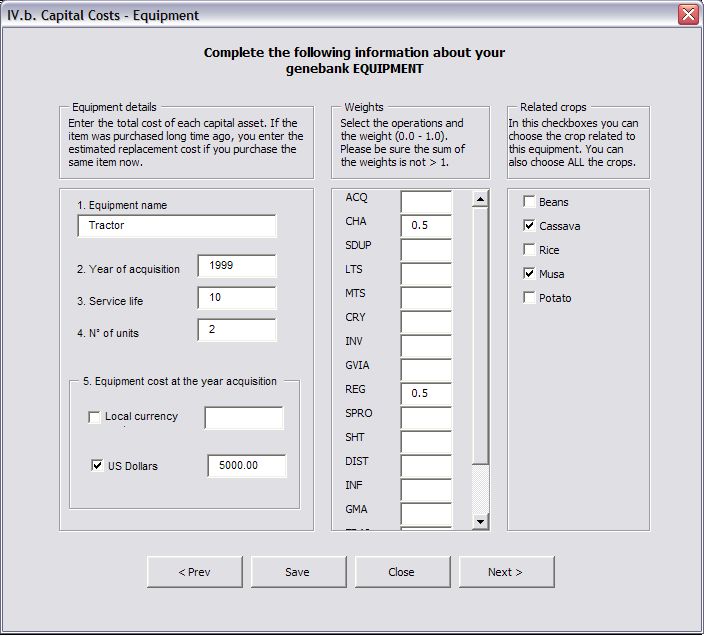
Quasi-fixed costs
Senior scientists and technicians are treated as quasi-fixed inputs. The assumption is that they are always needed, in particular to manage other staff, regardless of whether the genebanks overall workload grows or contracts. Quasi-fixed inputs are more variable than fixed capital inputs but unlike variable costs, they are not easily apportioned, when the size of the operation changes.
All the scientific staff and permanent staff working in the genebank are entered in this form. The first information requested is the staff title (e.g. technician, pathologist, agronomist, etc). The user has to enter the number of staff holding this title and the annual average salary paid to this category of staff.
Here, as in the case of capital costs, the user has to enter the weights or allocation rates according to operations that the staff are involved in. For instance if an agronomist is in charge of regeneration, characterization and seed processing of the materials, then the user has to enter the corresponding weight for this staff. The time allocation can be obtained directly from the staff or from the supervisors.
Some genebanks have scientific staff, who work on one specific crop. In other genebanks, the staffs' responsibilities are shared across type of materials. The user should be clear about this before completing this form. For instance the agronomist mentioned before could be in charge of crop 1 (c1) and crop 2 (c2). In that case then the user needs to click on c1 and c2.
Note that the salary information includes benefits, but it does not include indirect costs. The indirect costs and/or overhead rate are added later on.
Figure 9. Quasi-Fixed Costs - Labour form
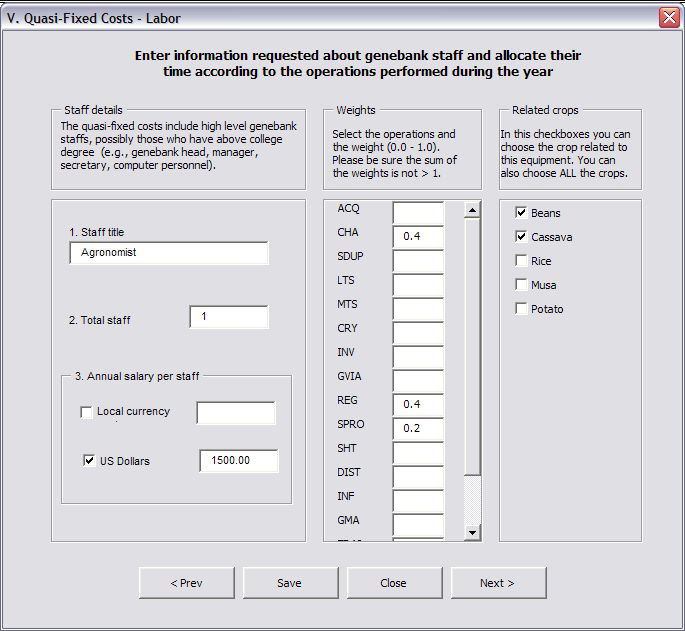
Variable labour costs
Variable inputs are sensitive to size of the operation. Variable inputs include non-labour costs and some labour costs. Variable labour costs refer to salaries paid to temporary workers and non-senior staff (and consultants, who perform temporary work within a given year). This form is completed in a similar manner to the one for Quasi-fixed costs.
All inputs used and expenses must be allocated by operation, using weights or allocation rates.
For example, the total cost of annually needed field labour for planting, harvesting and weeding is assigned to 0.8% to Regeneration and 0.2% to Medium-term storage. Allocating the inputs per type of operation requires expert knowledge about the demands of genebank operations. Genebank managers should be able to provide solid estimates, in consultation with their staff.
Figure 10. Variable Costs - Labour form
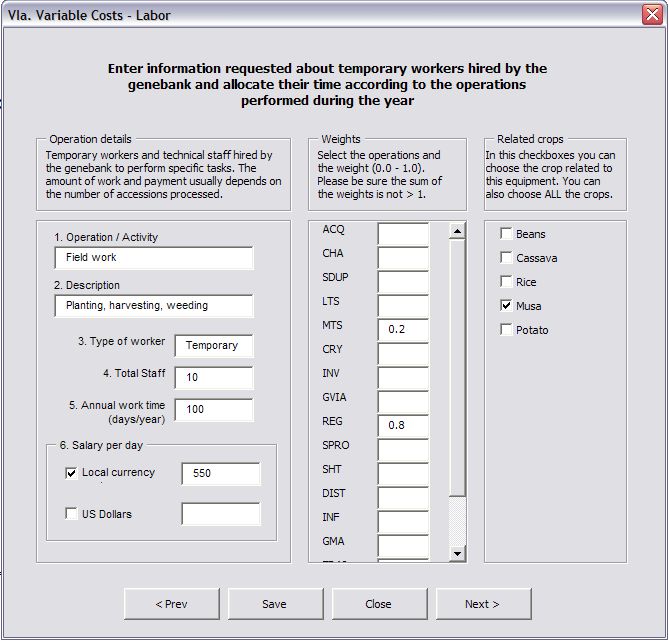
Variable Non-labour costs
Non-labour variable costs mainly include inputs consumed on a daily basis, like energy, office and laboratory supplies, per type of operation. For example, a genebank's total annual energy consumption needs to be divided up among all operations, which require energy. This category also includes the “direct, or service charges” that the Centers are in the process of implementing.
The user needs to enter detailed information about the name of supply or service, the annual use and the cost. The annual use is expressed in the same units as the price.
For instance if we are talking about fertilizer and the annual use is 50 bags (of 25kg) at a price of 250 pesos per bag, the user has to enter 50 in annual use, click on local currency and type 250 in the corresponding box. Fertilizer is used for field operations with weights of 0.6 for regeneration and 0.4 for characterization. Figure 11 illustrates this example.
Figure 11. Variable Costs - Non-labour form
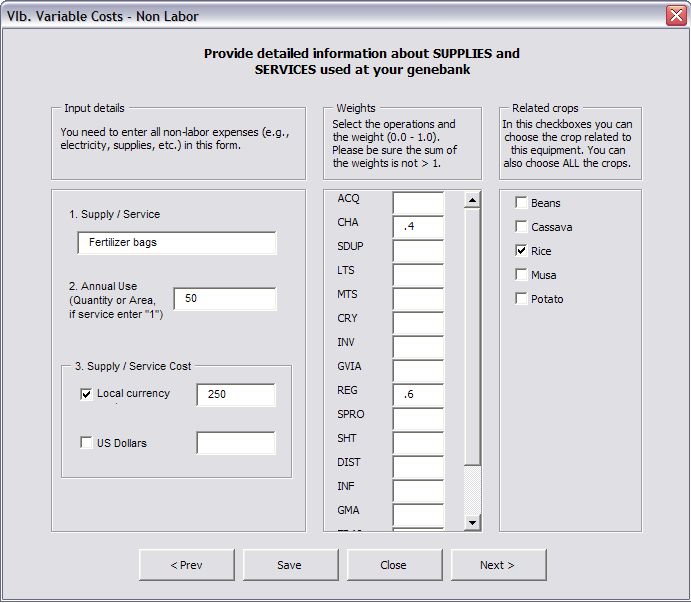
Note: The best way to collect this information is:
1. With the person responsible for each operation, develop a list of all consumables/supplies needed to perform the different activities that are involved in this operation. Note that information about temporary labour is entered separately.
2. To the best of your abilities, please enter the annual requirement of each supply as 1 unit of supply per x number of accessions and total that for a year.
For example, viability testing requires the use of petri dishes and paper. So if in a given year 2000 accessions were tested and the ‘unit of supply use’, per 1 accession, is 1 petri dish and 1 paper unit, then the annual use would be 2000 petri dishes, and 2000 filter paper units.
3. There will be a number of supplies used on a daily basis whose use is impossible to quantify per accession. In this case, estimate the volume of a particular item of supply used per annum.
4. For other supplies that are not quantifiable per accession and which are not used on a daily basis, or are not directly used in a particular activity (i.e. soap, printer ink, gloves, etc.), the user should get information about annual (lab) expenses from the finance department.
The DST has the potential to produce different types of output reports according to users’ needs.
The main report presents costs per input category, genetic material and operation. The report provides information about both total costs and average costs per accession, as shown in the report of total and average costs. The report also includes a graphic representation of the distribution of total costs. In the current version of the tool, this graph depicts the distribution of costs per input type, but other graphs could be developed based on expressed needs of genebank managers. This report could be used to keep updated information about the fluctuation of annual average costs across the years due to a number of factors like: exchange rate fluctuations, changes in the number of accession manipulated due to budget changes, effect of the overhead costs on total costs, effect of direct charges on the total and averages costs. The genebank manager can also use this report while deciding how to allocate resources across operations.
Two other kind of reports that can be generated using the tool:
1. A per-accession costs report of conservation and distribution. This report provides a wider picture of resources needed on an annual basis in order to fulfill the genebank goals. It can be use for fund raising purposes; and
2. Total annual and in-perpetuity costs of conserving and distributing all existing accessions in the genebank. This report could be used for funding purposes, as it helps in identifying all resources needed for keeping the genebank operating in perpetuity. This report answers the question of how much money is actually needed now to keep the genebank running in perpetuity at the current level of operation (given the number of accessions stored in and distributed from the genebank).
The Tool has been developed to record yearly information. Notice that the estimations in the report are based on one-year performance. There might be a large variation in the results as they can be affected by the conditions in a particular year. For instance if the information is collected for a particularly dry or particularly wet year, it is quite possible that the costs of field operations (i.e. characterization and regeneration) would be higher than normal. Ideally genebank cost estimations should be based on a number of years.
Section 2 of this guide presents how to use the Tool and enter the information for the very first time. After this, the information in the Tool needs to be updated annually:
- Capital costs: the user needs to verify that all the capital equipment listed in the database is still functional, or if some facility or equipment has been added or discarded.
- Quasi-fixed costs: similarly the user has to double check the staff listed under this category and make the necessary entries.
- Variable Labour and Non-labour costs: verify with the genebank staff the total number of temporary staff hired in the year. These values tend to change every year.
Notice that currently the forms are only to enter new information and do not allow for identification and deletion of old/outdated information. The user would need to go to the spreadsheets and make the necessary modifications manually.
The current version of the DST is more friendly for data entry and the generation of basic reports. There is, however, room for improvement:
- Ideally the information of several years should be stored automatically without the need to open a new file each year.
- The reports generated should be more detailed as the information over several years is accumulated.
- The use of add-in software could support the processing of the information and the presentation of results. For instance the use of @Risk software has help in the development of simulations. See Final Report Activity 2.4 (6.5MB) for examples.
Feedback from users is therefore very important for updating this Tool. Also notice that the file is unprotected, so the user can modify this program according to their needs.
References and further reading
Horna D, Kommerell V, Loayza M. 2010. Guide to Users. Decision Support Tool. Collective Action for Rehabilitation of Global Public Goods CGIAR Genetic Resources Systems - Phase 2 (GPG2). Available here (5.5MB).
Koo Bonwoo, Pardey PG, Wright BD, Bramel P, Debouck D, van Dusen ME, Jackson MT, Rao NK, Skovmand B, Taba S, Valkoun J. 2004. Saving seeds: The economics of conserving crop genetic resources ex situ in the Future Harvest Centres of the CGIAR. Oxfordshire: CABI Publishing.
Evaluating the Cost-Effectiveness of Collection Management: A Methodological Framework
Contributors to this page: IFPRI, Washington (Daniela Horna, Melinda Smale); Independent consultant (Bonwoo Koo); Bioversity International, Rome (Ehsan Dulloo); CIMMYT, Mexico (Thomas Payne); IRRI, Los Baños, Philippines(Ruaraidh Sackville-Hamilton); ILRI, Addis Ababa, Ethiopia (Jean Hanson); WARDA, Cotonou, Benin (Ines Sánchez); CIAT, Cali, Colombia (Daniel Debouck); Bioversity International, Belgium (Ines van der Houwe); ICRISAT, Patancheru, India (Hari Upadhyaya); Bioversity International, Ethiopia (Alexandra Jorge).
|
Introduction |
Conserving germplasm is a long-term activity that requires a long-term perspective, but genebanks are typically funded on a short-term basis (Koo et al. 2004). Phase 1 of the project “Collective Action for the Rehabilitation of Global Public Goods in the CGIAR Genetic Resources System” (GPG), the thorough analyses of conservation costs previously undertaken by the Systemwide Genetic Resources Program (SGRP) (summarized in Koo et al. 2004), and other economics research about the benefits of genebanks have demonstrated the importance of sustained funding and the high expected benefits of ex-situ conservation relative to costs, assuming “good practices” (summarized in Smale and Drucker, 2007; Smale and Koo 2003; for the case of a large national genebank, see also Day-Rubenstein et al. 2006).
The expansion of genebank collections from the 1970s through the 1990s led to management challenges. These included the duplication of accessions, backlogs in regeneration, and insufficient or untimely provision of information to users (Altoveros and Rao 1998; Engels and Rao 1998; Koo and Wright 2008) . At the same time, there was increasing recognition that integration and coordination of the collections as a global system offered important functional and economic advantages. In 1995, SGRP commissioned an external review of the CGIAR genebanks to provide an assessment of what was needed to meet conservation standards. The first phase of the GPG project addressed the main recommendations from this review, including amelioration of genebank facilities and genebank procedures.
The second phase of the project (GPG2) builds on the progress made in the first phase, with a focus on establishing good standards and practices in genebank operations and encouraging a systems perspective. The current challenge, as viewed by those engaged in this project, is not to increase the numbers of accessions, but to ensure the quality, security, accessibility and sustainability of the in-trust collections. An underlying assumption is that a better allocation of resources will lead to better performance.
Presently, genebanks operate according to protocol manuals. These manuals are recognized as useful, but they do not ensure best practices. Clearly, establishing a set of best practices based on performance indicators will increase the probabilities of delivering a high quality product because the chances of making a technical mistake will decrease. What is less clear is how these performance indicators relate to genebank expenditures. As genebank managers point out, in any case, there is a need to examine the cost-effectiveness of operations (output per cost).
The goal of the economics task in the GPG2 project is to develop and disseminate a computerized tool that will support strategic decision-making by genebank managers. The objectives of this document are to a) provide a conceptual framework for the tool and b) demonstrate how the tool can be used to evaluate the effects of decisions on the allocation of resources across operations. Effects of decisions are illustrated by two types of outputs: a) cost summary reports and b) sensitivity analysis with simulations. Thus, it is expected that genebank managers will be able to apply the tool to answer management questions and craft strategies in pursuit of good practices or to enhance their performance. Eventually, the tool could be generalized in order to explore the effects of resource allocation decisions within an integrated genebank system.
This study is divided into six sections. The second section discusses some fundamental concepts on which the framework is based. Section 3 outlines a decision support tool that builds on the work previously undertaken by the SGRP. This section describes the type of information genebank managers need to apply to the tool and the outputs that can be produced. Notice that a single set of cost data (representing one point in time) allows us to minimize cost only with respect to the technology and set of practices represented by those data. To draw conclusions concerning optimal allocation of resources within a single bank over time, and among banks, additional points corresponding to other technologies and practices are needed. Section 4 and 5 presents two additional analyses that can be conducted with additional observations: sensitivity analysis and regression analysis. In the last section, we discuss some considerations for the implementation of this framework as well as next steps for this activity.
Genebank operations
There is no disagreement over the main purpose of a genebank, which is to conserve genetic material and make it available to users. However, a review of genebank protocols suggests that agreement has not yet been reached on a general classification of activities and related terminology (Rao et al. 2006; Taba et al. 2004).
Pardey et al. (2001) and Koo et al. (2003) group genebank activities into operations performed to reach genebank objectives. Orienting their description toward “best practices,” Calles et al. (2007) classify genebank activities and inputs according to the specific objectives. Many operations are comparable across Centers, but other activities are specific to reproduction system of the crop, such as propagation and multiplication strategies. Seed propagated crops like wheat or rice are the easiest to handle and can be conserved for longer periods than clonal crops like cassava or banana (Rao et al. 2006). Figure 1a depicts some of the main activities of a seed germplasm bank. Figure 1b presents a generic flow of operations.
Figure 1. Genebank flow of operations
 a. General sequence of operations in a seed genebank (source: Rao NK et al. 2006) |
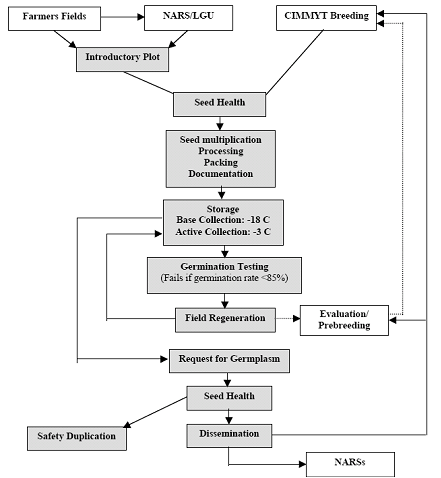 b. Generic flow of operations in a CG genebank (source: Pardey et al. 2001) |
In this study, an operation in understood as a cluster of activities and a number of operations are performed in order to reach a genebank objectives and thus genebank goals. Conservation and use of the genetic material are the two main goals of a germplasm bank. Specific objectives for achieving better conservation of genetic materials are:
- To cover the gene pool as much as possible
- To ensure the security (physical security and viability) of the genetic material
- To maintain its genetic integrity
Specific objectives for achieving a wider use of genetic materials are:
- To ensure the availability of the material to users
- To distribute the material
- To provide information
Best practices
The issue of quality standards is central to the management of any genebank. Genebanks in the CG system have operated with two sets of conservation standards: acceptable and preferred. Acceptable standards are considered to be minimal but adequate, while preferred standards guarantee better and safer conservation conditions. Evidently, meeting the preferred standards is more costly. Acceptable standards have been more frequently adopted as a consequence of budget constraints, leading to wide variation in quality standards across centers.
The CG genebanks are now directed toward “best practices,” which is a more dynamic, less easily defined concept of quality management. Genebank managers have not yet reached a consensus regarding the operational meaning of best practices. In some cases, “best practices” are viewed as activities that mitigate the risks that impede the achievement of objectives (conservation and use). In other cases, “best practices” are simple understood as the most effective practices given the technology that is currently available to the research center. In this study, we understand best practices as the costs incurred in order to reduce the chances of mistakes in technical procedures or in the delivery and distribution of genetic materials and related information to use. Different managers may have different degrees of tolerance of error probabilities, although they might agree on a standard threshold. Therefore the concept of best practices is directly linked to that of risk management. Ideally, implementing best practices based on performance levels as expressed by a set of indicators should minimize spending subject to an acceptable threshold of risk, a current conservation technology, and a current organization of collections. This would be one point of optimal resource allocation. Other optima would correspond to other conservation technologies, other risk thresholds, or a different organization of collections in the genebank system.
Performance indicators
Performance indicators measure the quality of an operation or a system in quantitative terms. Good performance indicators should be simple and measurable, while capturing the essential features of a complex system. Identifying performance indicators for the CG genebanks is another activity (No. 6.1.2) of the GPG project . Initial version of performance indicators identified for the GPG project are presented in Annex 1: Preliminary performance indicators for the GPG project. The task group has identified three kinds of performance indicators: technical operations indicators, impact and relevance indicators, and international collaboration indicators. For this study, only technical and impact indicators are considered to be relevant.
The framework proposed here would allow managers to discern how they might improve performance through re-allocating resources, or how they might maintain performance despite budget constraints. However, performance indicators must be defined in order to continue implementing the framework outlined in this document. The initial challenge is to make the right assumptions about the links among performance indicators, input use and costs. These links may not be as intuitive as expected. The variation in life cycle of the different operations conducted in the genebank, the share of resources allocated by genetic material, activity and/or operation diffuse the effect of input use on performance, making it difficult to isolate and establish causal relationships.
A review of CGIAR genebanks in the mid-1990s demonstrated the need for upgrading management of the in-trust collections. In response, SGRP organized a series of economic studies to determine the costs of the maintaining collections and proposed upgrade. The GPG project was established to facilitate the upgrade. During the first phase of the project, which started in 2003, in close consultation with several CG genebank managers, Koo et al (2004) compiled and analyzed genebank cost information.
The analytical framework for the cost studies was the micro-economic theory of production (Pardey et al. 2001). A genebank, like a firm, is organized to produce outputs (numbers of accessions characterized, stored, regenerated, etc.). Production decisions involve choosing which outputs to produce in which amounts, with which mix of inputs and input quantities. In the framework of economic decision-making, optimal resource allocation can be achieved either by minimizing the costs of operation given fixed physical resources and existing technology or by maximizing production subject to a fixed budget and existing technology. By duality theory, it has been proven that both approaches produce the same production possibility frontier. The production possibility frontier then traces the points corresponding to efficient resource allocations.
This approach selected by Koo et al. (2004) was cost minimization—for a very important, practical reason. Most of the benefits of genebank collections are public goods whose values are both expensive to estimate and likely to be unreliable estimated (see Smale and Koo 2003). By comparison, the costs of genebank operations are relatively easy to estimate with a fair degree of precision. Pardey et al. (2001) reasoned that if the costs of conserving an accession are shown to be lower than any sensible lower-bound estimate of the corresponding benefits, for many decisions, it may not be necessary to estimate benefits.
The data compiled by genebank managers on input use and expenditures was used to estimate average and marginal cost per unit. Average costs are the costs for the genebank of managing 1 accession. Marginal costs are the increase in total costs from the addition of one more accession to the genebank. Total costs include costs that vary and costs that are fixed in the relevant range of production. Average fixed or quasi-fixed (genebank management) costs normally decline as output increases. A standard assumption of micro-economic theory is that marginal costs initially decline as more is produced in a plant and eventually increase due to diminishing marginal returns to fixed factors (e.g., land, plant). Marginal cost is equal to average total costs when average total cost is at a minimum. Notice however that often genebanks operate below capacity, average costs then represent only upper bounds estimates of the marginal costs. Figure 2 illustrates how average and marginal costs are thought to change with amounts produced (for example, the number of seeds stored, regenerated, disseminated, etc).
The research summarized in Koo et al. (2004) represents only a single year of data for 5 CG Centers. In order to evaluate genebank costs more generally a broader cross-section and longer time series is vital. Unfortunately, genebank operation costs have not been systematically recorded in the CG system. This information must be gathered in a uniform and systematic way in order to facilitate comparison across genetic materials and across centers. The use of the decision support tool, described below, could facilitate the implementation of a system for periodic data collection by managers. Managers can use this information to monitor and evaluate their own performance, and as in input into strategic organizational decisions.
Figure 2. Genebank average and marginal cost
 (source: Pardey et al. 2001.) |
A prototype of a decision support tool has been developed based on the framework of Koo et al. (2004). The first purpose of the tool is to store detailed input use per operation and generate cost reports. So far, the tool has been developed as an excel file with an introduction sheet, a general information sheet, 3 input sheets (non-labor, labor and capital inputs) and 4 output sheets or reports (see Annex 2: Decision Support Tool). The introductory sheet provides a brief explanation of the purpose of the tool and the framework used to classify activities, inputs and costs. The general information sheet elicits details about the genebank (e.g., genetic material, number of accession managed, etc.) and other factors that affect costs (e.g., discount factor, overhead rate, period for performing operations).
Detailed input use and related expenses are entered in the decision tool, dividing the information by type of input (the categories are capital, labor and non-labor). In general, capital inputs are not sensitive to the size of the operation. Capital inputs include infrastructure, such as germplasm storage and genebank facilities, and equipment for field operations and offices. Variable inputs, on the other hand, are sensitive to size of the operation. Variable inputs include non-labor costs and some labor costs. Non-labor variable costs mainly include inputs consumed on a daily basis, like energy, office and laboratory supplies. Variable labor costs are salaries paid to temporary workers and non-senior staff. Senior scientists and technicians are treated as quasi-fixed inputs. Quasi-fixed inputs are more variable than fixed capital inputs but unlike variable costs, they are not easily apportioned when the size of the operation changes.
All inputs used and expenses must be allocated by operation using rates. For instance, the total energy consumption in a genebank must be distributed among all operations that required energy. Allocation requires expert knowledge about the demands of genebank operations. Genebank managers thus are the persons who, in consultation with their staff, are most able to provide good estimates of allocation rates. Information about inputs is used to determine capital costs, quasi-fixed cost, variable costs, and genebank total costs. Allocation rates disaggregate these costs per operation.
To produce output reports, total costs are broken down into capital, variable, and quasi-fixed costs. To illustrate, we used the example of the WARDA genebank in 2006, provided to us by the genebank manager. In addition to a summary overview by crop and input costs (see Annex 3: DST - Summary Report), three kinds of output reports can be generated. The first output reports costs per input category, genetic material, and operation, as shown in Table 1: DST Report1. The report provides information about both total costs and average costs per accession. The report also includes a graphic representation of the distribution of total costs (Figure 3). In the current version of the tool, this graph depicts the distribution of costs per input type, but other graphs could be developed based on expressed needs of genebank managers.
The second output corresponds to annual and in-perpetuity average cost per accession classified in terms of either conservation or distribution costs (Table 2: DST Report 2). Acquisition, viability testing, duplication, storage, and regeneration are operations that need to be performed in order to conserve an accession. Characterization, storage, regeneration, and dissemination are operations that are necessary in order to be able to distribute an accession. Costs are estimated for both new accessions and existing accessions, to indicate the additional cost of acquiring new accessions as compared to managing current accessions. The last output summarizes distribution and conservation costs associated with maintaining all existing genebank accessions (Table 3: DST Report 3). In this analysis, distribution costs are treated as short-run costs and conservation costs are considered to be “long-run” costs. This report shows the annual and in-perpetuity costs for the genebank. Such information is useful when justifying genebank funding or investment in ex-situ conservation.
While these reports help to understand the structure of genebank costs and their distribution across operations, objectives and over time, nothing can be inferred about the factors that affect these costs. For this reason, although it is possible to compare reports across genebanks, we do not have a picture that enables us to tackle strategic decisions. Two feasible ways to extend the use of the tool are discussed in the following sections.
Figure 3. Distribution of total risks
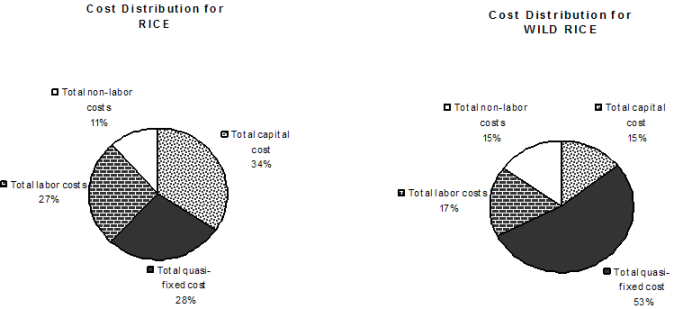 |
Sensitivity analysis with simulations
When it is augmented by sensitivity analysis and simulations, the decision tool can be used to investigate how genebank costs and genebank performance are affected by changes in key parameters. An impediment to analyzing genebank costs across centers is the limited information that is available. One way to overcome this impediment is to elicit a range of possible values for key factors from genebank managers. For instance, a statistical distribution of annual costs per accession, or in-perpetuity cost of conserving all accessions, could be generated based on elicited values.
The @Risk™ software can be used to define or adjust distributions to available data and to perform the sensitivity analysis. The software allows for the substitution of single point values with a probability distribution. A triangular distribution is the simplest distribution to elicit that approximates a normal distribution. This distribution is widely used in decision theory, especially when no sample data are available (Hardaker et al. 1997). The parameters defining the distribution are lowest, highest and most common value. Means, variances and coefficients of variation are easily tabulated from these three values, and repeated sampling from the distributions can be used to generate overall distributions.
For instance, let us take the number-of-accessions-regenerated-per-year (NREG) as an example of a factor affecting costs in the WARDA genebank. We can ask the genebank manager for his or her “best guess” of the highest, lowest and most common values for NREG conditional on a reference period and technology. Using these three parameters, the software then generates a distribution of values for NREG. We could also generate unconditional distributions across technologies. Instead of a single value for total costs of maintaining a rice accession in the WARDA genebank, we would then have a distribution of values. The software can evaluate the simultaneous effect of more than one factor (input variable) on one or more than one cost variable (output variable). Simulations results using WARDA genebank data are shown in Figures 4a and 4b.
Fig. 4a Distribution for average quasi-fixed cost, Rice, WARDA. Fig. 4b Regression sensitivity average quasi-fixed cost, Rice, WARDA
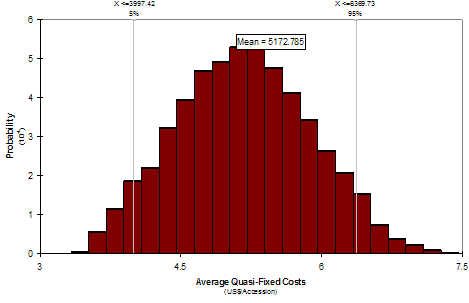

Instead of reporting just one value, figure 4a shows a distribution of values for average quasi-fixed cost of keeping one accession of rice in the WARDA genebank. This distribution of values respond to changes in: 1) number of accessions regenerated, 2) number of accessions distributed, 3) overhead rates, and 4) interval period for regeneration. Each of these variables has been replaced by a distribution of values. With this tool we can measure the effect of one or of multiple variables at the same time.
Figure 4b depicts the effect of individual distributions over the distribution of average quasi-fixed costs. From the factors evaluated (number of accessions regenerated, number of accessions distributed, overhead rate, and interval period to regeneration) overhead rate has the strongest effect on the increase of average quasi-fixed cost of rice accessions in the WARDA genebank. Average quasi-fixed costs decrease with an increase of number of accessions regenerated or distributed.
In the decision tool, factors affecting genebank costs are currently included in the “general information” sheet. Although preliminary simulations can be run based on this information, the aim of this task is to evaluate the relationship between performance and costs. As explained above, costs information is entered by activity. Certain activities must be performed in order to accomplish an operation. It is possible to find one or more performance indicators that are linked to an operation or an activity. The difficult in this case is that some inputs are used and activities performed for more than one operation. For example, regeneration is needed for conservation but also to ensure that genetic materials will be available for users (see Table 4: Relating genebank performance to costs).
Indices of genetic erosion might be used as performance indicators for the regeneration activity. Genebanks make use of variable, fixed and quasi-fixed inputs to regenerate the material and most importantly in order to maintain a low index of genetic erosion. If the genebank is not performing well and genetic erosion is high (or higher than the standard level/best practice recommendation), how should the manager allocate inputs in order to reduce the index of genetic erosion? Increasing a technician’s time in order to regenerate wild rice will most likely reduce the index of genetic erosion, but by how much? Thus, both the effect of input use on performance and the effect of performance on costs are difficult to grasp.
What would be the costs of reaching a “best practice” in the CG genebank system? How do location-specific variables affect genebanks costs? Genebank management decisions and their costs implications need to be evaluated to improve the performance of individual genebanks but also of the system as a whole. The second, longer-term objective the decision support tool is to provide answers to questions about the global genebank system. When enough observations have been assembled through application of the decision support tool, a genebank cost function can be estimated and specific hypotheses tested.
Genebanks costs depend on several factors: biological characteristics of the crop conserved, conservation methodology used (in vitro, field germplasm banks), institutional differences (wage structure, cost-sharing opportunities), local climate (for regeneration for instance, general state of infrastructure). The use of econometric methods will permit SGRP to evaluate the system as a whole by disaggregating the effect of the different factors and performance grade on costs. Once these effects have been taken into account in a multivariate regression, it will be feasible to draw conclusions across centers and genetic materials.
Cost function approaches have been used to model other public goods like hospitals and libraries, and this literature can provide insights into how we might specify genebanks costs. Finch and Christianson (1981) modeled the costs function of rural hospitals in US. The purpose of their study was to supply information about hospital costs that be used in making decisions regarding how the provision of health care to rural populations. The authors used quadratic and logistic specifications. The main advantage of the quadratic U-shape function is that a cost minimum can be determined given a fixed level of output. The logistic L-shape cost function implies that costs are decreasing but not in a constant rate to output, similar to what we assumed for genebanks. An additional contribution of this study is the use of output indicators to account for short run and long run costs. Conservation and distribution of genetic materials and information fit this characterization well.
Liu (2002) modeled a cost function for academic research libraries, taking into account the multi-product and multi-service nature of information provision by such organizations, which is comparable to genebanks. The author used a log-linear function and considered that some economies of scale exist in the operation of research libraries. Translog cost models have been also used for evaluating the costs function of research libraries. The use of a translog cost function is convenient when the goal is to determine elasticities of substitution among different inputs. De Boer (1992) used a translog cost function to examine economies of scale and input substitution elasticities of 194 Indiana public libraries.
If the objective of modeling genebank costs is to evaluate the relationship between cost and outputs with current technology and practices, logistic or quadratic specifications suit the purpose. If the objective is however to determine a technical relationship among inputs and outputs, a translog model would do better. It is always possible to test different specifications and evaluate which one adjusts better to our needs.
In specifying the model it is also important to define which cost to model: total costs or average (variable) cost. Modeling total costs would provide some additional information on capital and quasi-fixed costs. Since it is expected that changes in technology (mainly capital inputs) would improve performance of specific activities and operations, it may be better to model total costs than average variable costs. It is also possible to model total cost per operation.
Exogenous variables will include performance indicators for each output, a vector of crop characteristics, a vector of genebank characteristics, and a vector of staff characteristics. Genebank objectives can be classified according to either short or long term goals. This classification would help to determine short- and long-term minimum costs. Outputs related to conservation (covering genepool, maintaining genetic integrity and ensuring security) can be considered of a long-term nature while outputs of germplasm use (ensuring availability, providing information and germplasm distribution) are considered to be short-term outputs.
The general function could then be specified as:
|
TC=f(PI,Cr,Gb,St,L) |
PI = performance indicators (for either short of long term goals),
Cr = crop characteristics (multiplication strategy, fertilization, etc),
Gb = genebank characteristics (facilities, equipment),
St = staff characteristics (number, skills); and
L = location (dummies).
The selection of appropriate performance indicators is crucial. Conservation indicators might include the number of accessions stored, or indicators of diversity represented by the accessions. Indicators for use of germplasm might be the number of accessions added per year, the number of accession distributed, or the number of users of the genebank. Notice that the number of accessions added reflects the performance of genebank (technical operations) directly, while the other two indicators are related more directly to users and might be more appropriate if the goal is to measure the impact of a genebank.
The vector of crop characteristics includes the type of fertilization (open pollination, cross pollination) and type of seed reproduction system (sexual, clonal, tissue culture, etc). Differences in crops and reproduction system have a definitive effect on the costs. Genebank characteristics that can influence the cost function are related to the type of equipment and facilities. This information is also valuable to determine if the genebank is operating under excess capacity or not, and thus where economies of scale might be achieved. Staff characteristics variables can help to explain the effect on costs of staff qualification and the number of staff working in the genebank. The use of dummy variables is recommended to factor out location specific effects.
-
The decision support tool is in an early stage of development. The framework used to develop the tool (activities, operations, objectives, etc) is based on research produced during the first phase of the GPG project. The goal of this work is to produce a flexible tool that can be adjusted to represent a range of operations and genetic materials.
-
A consensus regarding a set of simple, quantifiable performance indicators is central to further progress in developing the tool. To be useful, the tool must be modified in order to incorporate data that measure performance.
-
The tool can be used to produce annual costs reports and a sensitivity analysis based on simulations. These evaluations can be accomplished per genetic material in a specific genebank. The longer term goal, however, is to evaluate genebank performance for the global genebank system. The tool can be used to assemble relevant data, and based on a review of cost studies of provision of public goods, we recommend econometric analysis as a means of evaluating the system.
-
The next steps involved in implementing the decision support tool are: a) assemble input use, costs information and feedback from genebank managers, b) add an input sheet for entering performance indicators, c) examine, with genebank managers, how costs can be structurally linked to performance indicators.
References and further reading
Altoveros NC, Ramanatha Rao V. 1998. Analysis of information on seed germplasm regeneration practices. In: Engels JMM, Ramanatha Rao V, editors. Regeneration of Seed Crops and their Wild Relatives: Proceedings of a Consultation Meeting, 4-7 December 1995, ICRISAT, Hyderabad, India. IPGRI, Rome, Italy. Available here.
Burstin J, Lefort M, Mitteau M, Sontot A, Guiard J. 1997. Towards the assessment of the costs of genebank management: conservation, regeneration, and characterization. Plant Varieties and Seeds 10: 163-172.
Calles T, Dulloo ME, Engels JMM, van den Houwe I. 2007. Best practices for germplasm management: A new approach for achieving genebank standards. Bioversity International. Available here.
Day-Rubenstein K, Heisey P, Shoemaker R, Sullivan J, Frisvold G. 2005. Crop genetic resources: An economic appraisal. A report from the economic research service. Economic Information Bulletin Number 2. United Stated Department of Agriculture.
De Boer L. 1992. Economies of scale and input substitution in public libraries. Journal of Urban Economics 32 (2): 257-268.
Engels JMM, Ramanatha Rao V. 1998. Regeneration of Seed Crops and their Wild Relatives: Proceedings of a Consultation Meeting, 4-7 December 1995, ICRISAT, Hyderabad, India. IPGRI, Rome, Italy. Available here.
Finch L, Christianson JB. 1981. Rural hospitals costs: an analysis with policy implications. Public Health Reports 96: 423-433.
Fowler C, Hodgkin T. 2004. Plant genetic resources for food and agriculture: Assessing global availability. Annual Review of Environment and Resources. Vol. 29: 143-179 .
Hardaker JB, Huirne RBM, Anderson JR. 1997. Coping with risk in agriculture. Wallingford: CAB International.
Horna D, Smale M et al. 2010. Evaluating the Cost-Effectiveness of Collection Mangement: A Methodological Framework. Collective Action for Rehabilitation of Global Public Goods CGIAR Genetic Resources Systems - Phase 2 (GPG2). Available here (5.8MB).
Koo B, Pardey PG, Wright BD. 2003. The economic costs of conserving genetic resources at the CGIAR centres. Agricultural Economics 29: 287-297.
Koo Bonwoo, Pardey PG, Wright BD, Bramel P, Debouck D, van Dusen ME, Jackson MT, Rao NK, Skovmand B, Taba S, Valkoun J. 2004. Saving seeds: The economics of conserving crop genetic resources ex-situ in the future harvest centres of the CGIAR. Oxfordshire: CABI Publishing.
Koo B, Wright BD. 2008. The optimal timing of evaluation genebank accessions and the effects of biotechnology. American Journal of Agricultural Economics 82 (4): 797-811.
Liu LG. 2002. The cost functions and scale economies in academic research libraries. Library Trends 2002: 406-420.
Pardey PG, Koo B, van Dusen ME, Skovmand B, Taba S. 2001. Costing the Conservation of Genetic Resources: CIMMYT's Ex Situ Maize and Wheat Collection. Crop Science 41: 1286-1299.
Rao NK, Hanson J, Dulloo ME, Ghosh K, Nowel D, Larinde M. 2006. Manual of seed handling in genebanks. Handbooks for Genebanks No. 8. Bioversity International, Rome, Italy. Available in English (1.5 MB), Spanish (1.4 MB) and French (1.9 MB).
Smale M, Drucker AG. 2007. Agricultural Development and the Diversity of Crop and Livestock Genetic Resources: A Review of the Economics Literature. In: Kontoleon A, Pascual U, Swanson T, editors. Biodiversity Economics. Cambridge University Press.
Smale M, Koo B. 2003. Genetic Resources Policies: What is a Gene Bank Worth? IFPRI: Washington, D.C.: IFPRI, IPGRI, and the Systemwide Genetic Resources Program.
Taba S, van Ginkel D, Hoisington D, Poland D. 2004. Wellhausen-Anderson Plant Genetic Resources Center: Operations Manual. El Batan, Mexico: CMMYT.
Upadhayaya H, Gowda CLL, Sastry DVSSR. 2008. Plant genetic resources management: collection, characterization, conservation and utilization. SAT eJournal (ejournal.icrisat.org) An Open Source Journal published by ICRISAT: December 2006, Volume 6.
Virchow D. 2003. Current expenditures on crop genetic resources activities. In: Virchow D, editor. Efficient conservation of crop genetic diversity. Berlin: Springer-Verlag.
Virchow D. 1999. Spending on conservation of plant genetic resources for food and agriculture: How much and How efficient? ZEF Discussion Papers on Development Policy. Bonn: Center for Development Research.



 decision support tool
decision support tool


